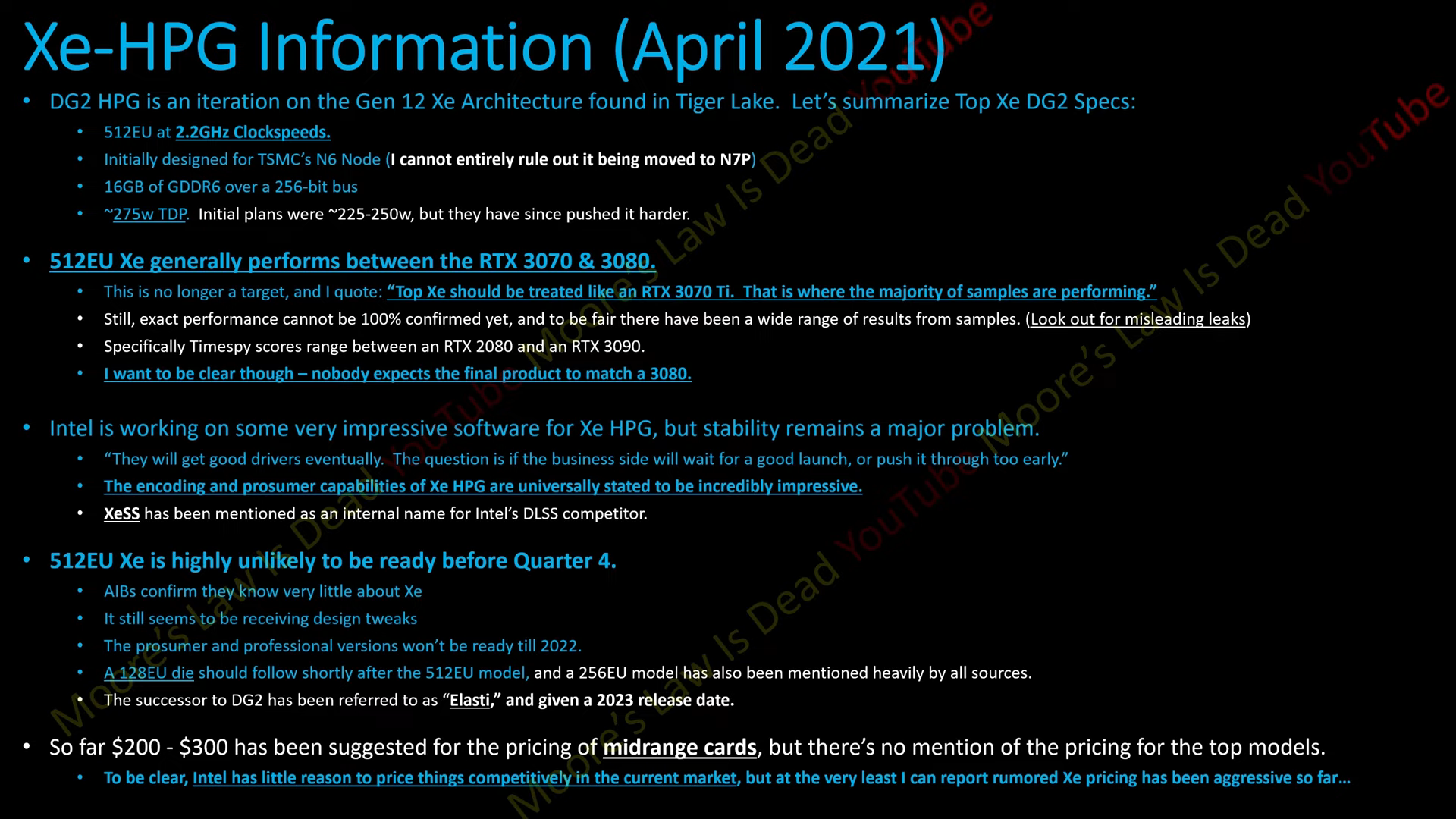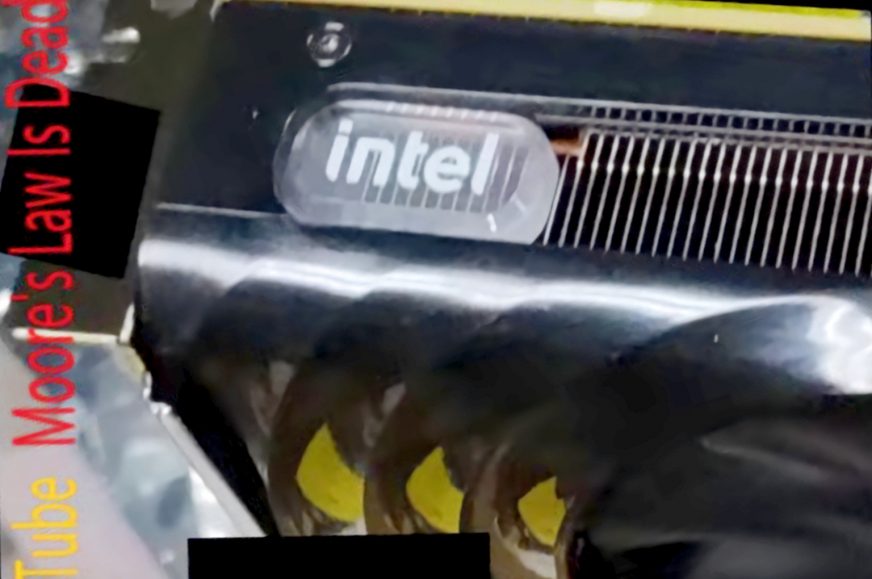First pictures of Intel’s gaming card
Very first photos of the 2nd generation Intel’s standalone GPU have been leaked, maybe a little earlier than expected. This timeit is not the small and feeble mobile GPU Iris Xe Max, which could only compare to GeForce MX, but the Xe HPG gaming graphics. The card in the photos allegedly has a TDP of up to 275 W, supports ray tracing, AI upscaling and its performance should be somewhere around Nvidia GeForce RTX 3070 Ti.
A YouTuber nicknamed Moore’s Law is Dead has received photos of what is likely a real prototype of Intel Xe HPG card with a DG2 chip, that will have up to 512 EU (4096 shaders), ray tracing support and performance somewhere above GeForce RTX 3070 or around the upcoming RTX 3070 Ti.
You can see the pictures below. They likely depict an ES sample, not a final design of the card. This means that it may not match the form of the cards that will go on sale. But at the same time, it doesn’t look like an early prototype either, as no PCBs or extra connectors for diagnostics are visible, and the design includes various decorative elements. So maybe this card could also be a sample for mass production – similar to the early samples of the Founders Edition Ampere graphics leaked last June. Furthermore, according to the leaker, the cooler cover could be white instead of black in the final version, and Intel is said to have been developing other designs as well, one of them significantly more sophisticated. This cooler and cover therefore might just be a temporary solution used to validate and test the GPU (which is what’s happening in Intel at this moment).

The card comes with a non-reference type cooler with two axial fans, but no heatpipes are visible on the side, so it probably uses a vapor chamber. As with the reference Radeon RX 6000, the fins run across the card, i.e. vertically from motherboard when the card is installed. Half of the warm air will be exhausted through the open gap in the edge of the cooler, but the other part will be directed towards the motherboard’s PCB, which is however a trade-off that is inevitable with this design.

The GPU itself is unfortunately not exposed in the photos, but we do see the power connectors. There’s one 6-pin and one 8-pin, which is the same configuration as for example the 230W Radeon RX 6700 XT. However, according to the source of the photos, the power draw is somewhat higher than that. Originally, Intel reportedly planned the TDP to be 225 to 250 W, but eventually raised it to 275 W, i.e. halfway between the Radeon RX 6800 and RX 6800 XT. This may be because Intel has raised clock speed (and performance) higher than they were originally supposed to be, or alternatively, the chip proved to have somewhat worse efficiency than planned.

2.2 GHz GPU clock speed
According to the information in the video – which could be quite credible given how the leaker was able to obtain photos from his sources – the version of Intel Xe HPG with 512 EU/4096 shaders should operate at 2.2 GHz – which should require the 275W TDP. The chip is to be manufactured on TSMC’s 6nm (N6) process.
The card is supposed to have 16 GB GDDR6 memory on a 256-bit bus, as mentioned in previous leaks. 16.0 GHz effective memory clock might be used (bandwidth would be 512 GB/s), but this has not yet been confirmed.
Performance at around the RTX 3070 Ti
The performance of the full configuration with 512 EU is said to be between the GeForce RTX 3070 and RTX 3080 – it won’t match the latter, but it could end up roughly equal to the upcoming GeForce RTX 3070 Ti (and therefore possibly also able to compete with the Radeon RX 6800?). Of course, performance may vary from game to game due to a different architecture, but on average it should be somewhere around the yet unreleased RTX 3070 Ti, or at least RTX 3070.
XeSS?
Naturally, drivers could turn out to be be a potential problem. Good news for those interested in these cards is that Intel is already working on an alternative to Nvidia’s DLSS upscaling. Moore’s Law is Dead says that the project name is XeSS, but the feature’s official name might be different in the end. By the way, the card is also said to give very good results in creative applications acceleration and video acceleration (encoding). Information from Moore’s Law is Dead suggests that the GPU could support AV1 hardware encoding, which competing GPUs now lack.

Release by the end of the year?
Moore’s Law is Dead also states that these cards will not just come on the market yet. Partner manufacturers, who could also be the main producers and sellers of the cards, as is the current practice with AMD and Nvidia cards, have not received much information about these graphics cards yet, so they have not yet started preparations and the PCB card design is likely still being worked on. Based on that, it seems that this graphics card will probably only start selling in Q4 of this year (October to December). This applies to the gaming version; the professional model for workstations, CAD and the like, are said to arrive even later, in 2022.
Intel is said to first release the most expensive and most powerful model, the 512 EU 2.2 GHz card with GeForce RTX 3070 (Ti) performance. A little later (allegedly it shouldn’t take long, maybe a month or two) a cheap version with 128 EU (1024 shaders) is supposed to be released. Somewhere between these GPU releases, a card with 256 EU (2048 shaders) should arrive, which may come out later as the third wave, however.
So, things are starting to look pretty interesting with Intel’s graphics ambitions. It’s true that we don’t know the prices yet, but in the current mass madness around cryptocurrencies, those would be far from reality anyway, and who knows if or when will some semblance of sanity return to the market.
But if these factors were not involved, it is said that Intel generally wants to implement a rather aggressive pricing policy in order to gain as much favor with the customers as possible at the start. It could mean that some mid-range models could cost somewhere between $200 and $300. But the price for the 512 EU version would probably be higher, nothing is known about that SKU’s MSRP so far.
Sources: Moore’s Law is Dead, VideoCardz
Translated, original text by:
Jan Olšan, editor for Cnews.cz








